The solutions to Bridges in Mathematics Grade 3 Student Book Answer Key Unit 7 Module 4 can help students to clear their doubts quickly.
Bridges in Mathematics Grade 3 Student Book Answer Key Unit 7 Module 4
Bridges in Mathematics Grade 3 Student Book Unit 7 Module 4 Session 1 Answer Key
Work Place Instructions 7B Racing Fractions
Each pair of players needs:
- 7B Racing Fractions Game Board (1 copy per player)
- 5 red game markers
- 5 blue game markers
- 1 deck of Number Cards with the 0s, 5s, 7s, 9s, 10s, and wild cards removed
1. Players decide who will play with the red game markers and who will play with the blue markers. Then both players place one of their game markers at the beginning of each number line on their own game board.
2. Players shuffle the Number Cards and lay them face-down in a stack. Each player draws two cards, and uses them to form a fraction. The player with the larger fraction goes first. Players put the cards just drawn at the bottom of the stack.
Players must use the smaller of the two numbers they drew as the numerator, and the larger as the denominator now and throughout the game.
3. Player 1 draws two new cards, uses them to form a fraction, and moves one or more game markers the distance shown on the card. Player 2 checks Player 1’s work.
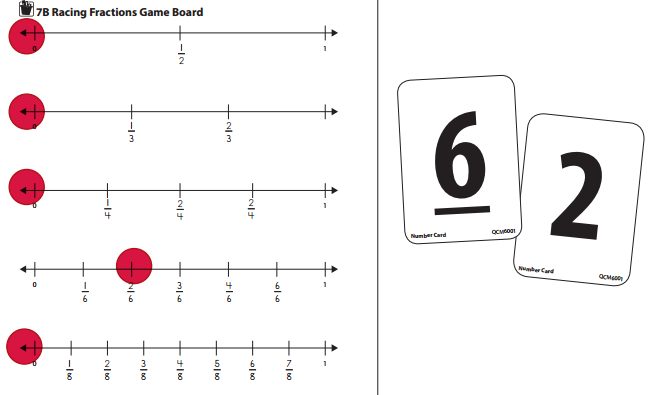
Player 1 OK, I got a 6 and a 2.1 have to use the smaller number on the top of the fraction, so that’s two-sixths. I think I’m just going to move the marker on the line for the sixths—one-sixth, two-sixths, your turn!
4. Then Player 2 draws two Number Cards and takes a turn. Player 1 checks the second player’s work.
5. Players continue to take turns and check each other’s work until one player’s game markers are all on 1. If Player 1 is the first to get all of her markers on 1, Player 2 may take one last turn.
- If a player cannot find a possible move for a card he has drawn, the player loses the turn.
- Players may also move game markers backward. For example, if a player gets the cards 2 and 3 to make the fraction \(\frac{2}{3}\), she can move one marker up \(\frac{1}{3}\) and another back \(\frac{2}{6}\). The sum of the moves still needs to equal the value of the fraction.
- Players must go out exactly. In other words, if a player has all his markers except one on 1, with just \(\frac{1}{4}\) left to go on one line, and he draws a 1 and a 2 to form the fraction \(\frac{1}{2}\), he loses the turn.
Game Variations
A. Play cooperatively. Players can work together and help each other finish the track in a certain time period.
B. Both players place one of their game markers at the end of each number line on their own game board. Then they race to see who can be first to get the markers on all their lines back to 0.
C. Players can use either of the cards they draw on a given turn as the numerator or the denominator. For example, if a player draws the cards 6 and 3, she can arrange those cards to form either \(\frac{3}{6}\) or \(\frac{6}{3}\).
Garden Patch Problems
Question 1.
Liam wanted to put a fence around his vegetable garden patch. His brother asked him to put a fence around his garden patch too. Liam’s garden patch was 5 feet wide and 10 feet long. His brother’s patch was 6 feet wide and 7 feet long. How many feet of fencing will Liam need? Show all your work.
Answer:
30 feet of fencing Liam needs.
Explanation:
Length of Liam’s garden patch = 10 feet.
Breadth of Liam’s garden patch = 5 feet.
Perimeter of Liam’s garden patch = 2 × (Length of Liam’s garden patch + Breadth of Liam’s garden patch)
= 2 × (10 + 5)
= 2 × 15
= 30 feet.
Question 2.
Liam bought too much fencing and had 26 feet of it left over. He and his brother decided to make a rectangle-shaped garden patch for their little sister. They wanted to use all the extra fencing to outline her garden patch. What could be the dimensions of the patch they make for their sister? (Use only whole numbers of feet.) Show all your work.

Answer:
The dimensions of the patch they make for their sister can be 7 feet or 8 feet long and 6 feet or 5 feet wide.
Explanation:
Number of feet of fencing is left over = 26.
Perimeter of Liam’s garden patch = 30 feet.
They wanted to use all the extra fencing to outline her garden patch.
=> Perimeter = 2(Length + Breadth)
26 feet = 2(Length + Breadth)
=> 26 × 2 = (Length + Breadth)
=> 13 feet = (Length + Breadth).
=> 13 = 7 + 6
=> 13 = 8 + 5.
Question 3.
CHALLENGE Draw and label two other ways Liam and his brother could use all 26 feet of fencing for their sister’s garden.
Answer:
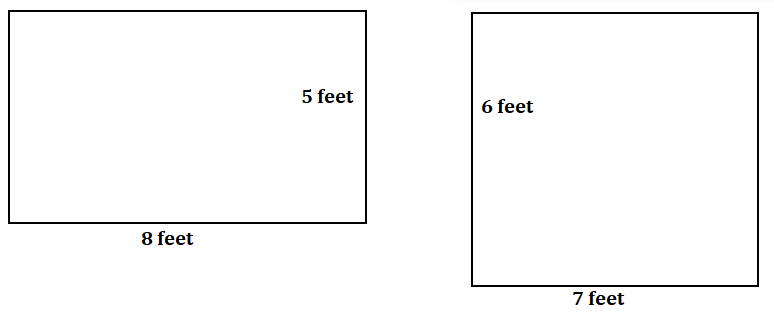
Explanation:
The length of fencing for their sister’s garden can be 7 or 8feet.
Breadth of fencing for their sister’s garden can be 6 or 5feet.
Bridges in Mathematics Grade 3 Student Book Unit 7 Module 4 Session 2 Answer Key
Sharing Pizzas Record Sheet
Write the number of kids your team is working with in the spaces provided. Then solve each problem using the paper pizzas. Glue the paper pizza pieces in the boxes to show how you divided the pizzas evenly between the kids. Include a sentence telling how much pizza each kid gets.
My team is dividing pizzas evenly between _____________ kids.
Question 1.
What happens when ____________ kids share 2 pizzas?
Answer:
Each kid gets 4 pieces of pizza sharing 2 pizzas.
Explanation:
Number of kids in my team = 3.
Number of pieces in each pizza = 6.
Number of pizzas = 2.
Number of pieces each kid gets = (Number of pizzas × Number of pieces in each pizza) ÷ Number of kids in my team
= (2 × 6) ÷ 3
= 12 ÷ 3
= 4.
Question 2.
What happens when ____________ kids share 3 pizzas?
Answer:
Each kid gets 6 pieces of pizza sharing 3 pizzas.
Explanation:
Number of kids in my team = 3.
Number of pieces in each pizza = 6.
Number of pizzas = 3.
Number of pieces each kid gets = (Number of pizzas × Number of pieces in each pizza) ÷ Number of kids in my team
= (3 × 6) ÷ 3
= 18 ÷ 3
= 6.
Question 3.
What happens when __________ kids share 4 pizzas?
Answer:
Each kid gets 8 pieces of pizza sharing 3 pizzas.
Explanation:
Number of kids in my team = 3.
Number of pieces in each pizza = 6.
Number of pizzas = 4.
Number of pieces each kid gets = (Number of pizzas × Number of pieces in each pizza) ÷ Number of kids in my team
= (4 × 6) ÷ 3
= 24 ÷ 3
= 8.
Pizza Problems
Question 1.
You can use some of your leftover paper pizzas to help you solve these problems or you can draw your own circles.
a. Jim and Emma were eating pizza for lunch. Jim ate \(\frac{2}{6}\) of the pizza. Emma ate \(\frac{3}{6}\) of the pizza. How much pizza did they eat in all? Use labeled sketches, numbers, or words to explain how you got the answer.
Answer:
Number of pieces of pizza they ate in all = \(\frac{5}{6}\).
Explanation:
Number of pieces of pizza Jim ate = \(\frac{2}{6}\).
Number of pieces of pizza Emma ate = \(\frac{3}{6}\).
Number of pieces of pizza they ate in all = Number of pieces of pizza Jim ate + Number of pieces of pizza Emma ate
= \(\frac{2}{6}\) + \(\frac{3}{6}\)
= (2 + 3) ÷ 6
= \(\frac{5}{6}\).
b. Rosa and Carmen made two mini-pizzas for lunch. They cut both pizzas into fourths. Rosa ate \(\frac{3}{4}\) of a pizza. Carmen ate \(\frac{3}{4}\) of a pizza. How much pizza did they eat in all? Use labeled sketches, numbers, or words to explain how you got the answer.
Answer:
Number of pieces of pizza they ate in all = \(\frac{6}{4}\) or \(\frac{3}{2}\).
Explanation:
Number of pieces of pizza Rosa ate = \(\frac{3}{4}\).
Number of pieces of pizza Carmen ate = \(\frac{3}{4}\).
Number of pieces of pizza they ate in all = Number of pieces of pizza Rosa ate + Number of pieces of pizza Carmen ate
= \(\frac{3}{4}\) + \(\frac{3}{4}\)
= (3 + 3) ÷ 4
= \(\frac{6}{4}\)
= \(\frac{3}{2}\).
c. CHALLENGE Carl and his brother Noel ordered a pizza. Carl ate \(\frac{1}{4}\) of the pizza. Noel ate \(\frac{2}{4}\) of the pizza. How much of the pizza did they eat in all? Use labeled sketches, numbers, or words to explain how you got the answer.
Answer:
Number of pieces of pizza they ate in all = \(\frac{3}{4}\).
Explanation:
Number of pieces of pizza Carl ate = \(\frac{1}{4}\).
Number of pieces of pizza Noel ate = \(\frac{2}{4}\).
Number of pieces of pizza they ate in all = Number of pieces of pizza Carl ate + Number of pieces of pizza Noel ate
= \(\frac{1}{4}\) + \(\frac{2}{4}\)
= (1 +2) ÷ 4
= \(\frac{3}{4}\).
Question 2.
Write each of these fractions where they belong on the number line: 1, \(\frac{2}{3}\), \(\frac{3}{4}\), \(\frac{1}{3}\), \(\frac{5}{6}\), \(\frac{3}{3}\), 1, \(\frac{1}{2}\).

Answer:

Explanation:
Given Fractions:
1
\(\frac{2}{3}\) = 0.67.
\(\frac{3}{4}\) = 0.75.
\(\frac{1}{3}\) = 0.33.
\(\frac{5}{6}\) = 0.83.
\(\frac{3}{3}\) = 1.
1
\(\frac{1}{2}\) = 0.5.
Bridges in Mathematics Grade 3 Student Book Unit 7 Module 4 Session 3 Answer Key
Student Survey
Question 1.
Here is the question I want to ask my classmates:
Answer:
Do students likes pizzas or not is the question I want to ask my classmates.
Explanation:
My question to my classmates:
Do students likes pizzas or not.
Question 2.
Here are the answer choices (please provide two or three possible answers):
a
b
c
Answer:
a. Number of students likes pizzas = 20.
b. Number of students donot like pizzas = 11.
Explanation:
Question: Do students likes pizzas or not is the question I want to ask my classmates.
Answer:
a. Number of students likes pizzas = 20.
b. Number of students donot like pizzas = 11.
Question 3.
Here are my predictions about the results of this survey:
Answer:
More than 65% students likes pizzas and 35% donot like pizzas is my predictions about the results of this survey.
Explanation:
My predictions about the results of this survey:
More than 65% students likes pizzas and 35% donot like pizzas.
Question 4.
Ask exactly 12 classmates your question. Record and organize their answers below or on another piece of paper.
Answer:
Number of students likes pizzas = 8.
Number of students donot like pizzas = 4.
Explanation:
My question to my classmates:
Do students likes pizzas or not.
Number of students likes pizzas = 8.
Number of students donot like pizzas = 4.
Circle Graph Record Sheet
Title _____________________
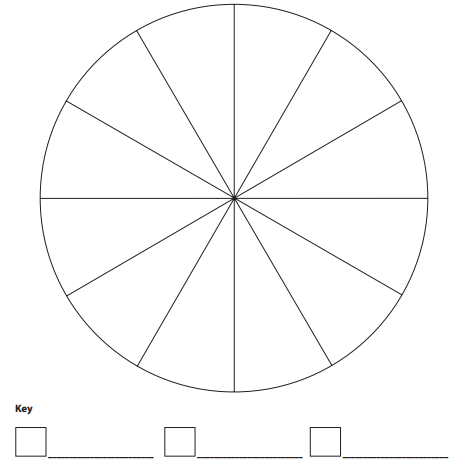
Answer:

Explanation:
My question to my classmates:
Do students likes pizzas or not.
Total number of students = 12.
Number of students likes pizzas = 8.
Number of students donot like pizzas = 4.
Fraction Action
Solve each story problem below. Use the example to see how to show your work.
ex: Sam and Sophia are playing basketball. Sophia has scored 16 points. Sam has scored half as many points as Sophia.
a. Make a labeled sketch to show how many points Sam has scored.
Answer:
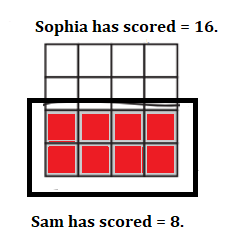
Explanation:
Number of points Sophia has scored = 16.
Sam has scored half as many points as Sophia.
=> Number of points Sam has scored = Number of points Sophia has scored ÷ 2
= 16 ÷ 2
= 8.
b. How many points has Sam scored?
Answer:
Sam scored 8 points.
Explanation:
Number of points Sophia has scored = 16.
Sam has scored half as many points as Sophia.
=> Number of points Sam has scored = Number of points Sophia has scored ÷ 2
= 16 ÷ 2
= 8.
Question 1.
Sam and Sophia play basketball again. This time, Sophia scored 12 points and Sam scored one-third as many points as Sophia.
a. Make a labeled sketch to show how many points Sam scored.
Answer:
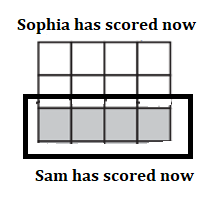
Explanation:
Number of points Sophia has scored now= 12.
Sam scored one-third as many points as Sophia.
=> Number of points Sam has scored now = Number of points Sophia has scored × \(\frac{1}{3}\)
= 12 × \(\frac{1}{3}\)
= 4.
b. How many points did Sam score?
Answer:
4 points Sam scored.
Explanation:
Number of points Sophia has scored now= 12.
Sam scored one-third as many points as Sophia.
=> Number of points Sam has scored now = Number of points Sophia has scored × \(\frac{1}{3}\)
= 12 × \(\frac{1}{3}\)
= 4.
Question 2.
On another day, Sam and Sophia play soccer. Sam scored 8 points. Sophia scored one-fourth as many points as Sam.
a. Make a labeled sketch to show how many points Sophia scored.
Answer:
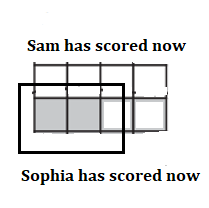
Explanation:
Number of points Sam has scored now= 8.
Sophia scored one-fourth as many points as Sam.
=> Number of points Sophia has scored now = Number of points Sam has scored × \(\frac{1}{4}\)
= 8 × \(\frac{1}{4}\)
= 2.
b. How many points did Sophia score?
Answer:
2 points Sophia scored.
Explanation:
Number of points Sam has scored now= 8.
Sophia scored one-fourth as many points as Sam.
=> Number of points Sophia has scored now = Number of points Sam has scored × \(\frac{1}{4}\)
= 8 × \(\frac{1}{4}\)
= 2.
Question 3.
Solve the following problems:
(5 × 10) × 2 = ______________
(2 × 5) × 10 = ______________
3 × (6 × 10) = ______________
6 × (3 × 10) = ______________
Answer:
Equations:
(5 × 10) × 2 = 100.
(2 × 5) × 10 = 100.
3 × (6 × 10) = 180.
6 × (3 × 10) = 180.
Explanation:
Given Equations:
(5 × 10) × 2 = ??
=> 50 × 2
= 100.
(2 × 5) × 10 = ??
=> 10 × 10
=> 100.
3 × (6 × 10) = ??
=> 3 × 60
=> 180.
6 × (3 × 10) = ??
=> 6 × 30
=> 180.
Bridges in Mathematics Grade 3 Student Book Unit 7 Module 4 Session 4 Answer Key
Pull & Graph Record Sheet
Put 8 green and 4 yellow tiles in a bag. Shake the bag well. Pull out a tile and record its color by filling in 1 section on the circle graph below. Return the tile to the bag, shake well, pull out another tile, and record the color on the circle graph below. Do this 12 times.
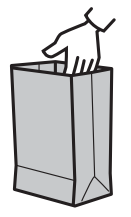
Be sure to put the tile back in the bag and shake it again each time.
What do you predict will happen? Why?
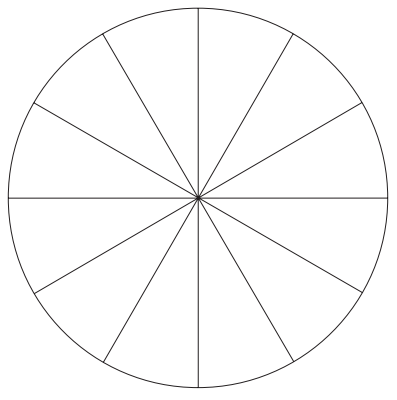
Green came out ![]() of the time. Yellow came out
of the time. Yellow came out ![]() of the time.
of the time.
Answer:
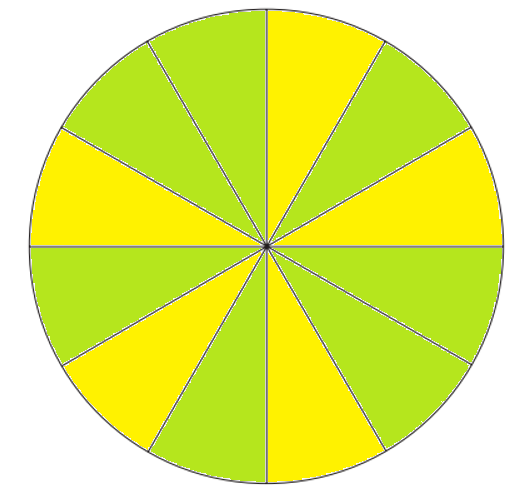
Green came out \(\frac{7}{12}\) of the time. Yellow came out \(\frac{5}{12}\) of the time.
Explanation:
Total number of times spinning the tiles = 12.
Number of times Green tiles came = 7.
Fraction of Green tiles came = Number of times Green tiles came ÷ Total number of times spinning the tiles
= 7 ÷ 12 or \(\frac{7}{12}\).
Number of times Yellow tiles came = 5.
Fraction of Yellow tiles came = Number of times Yellow tiles came ÷ Total number of times spinning the tiles
= 5 ÷ 12 or \(\frac{5}{12}\)
Comparing Fractions on a Number Line
When you are comparing fractions, it can help to think about how close those fractions are to landmarks like one whole and one-half. Use the number line to help complete the problems below.

Question 1.
Complete the table.
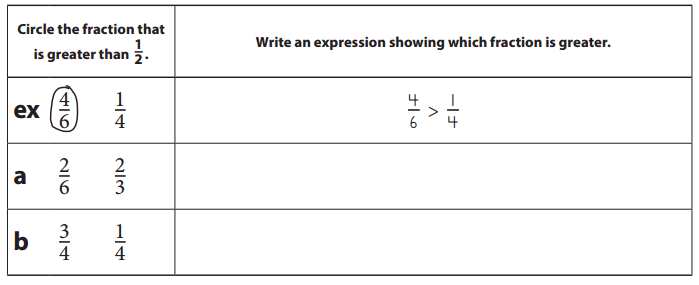
Answer:
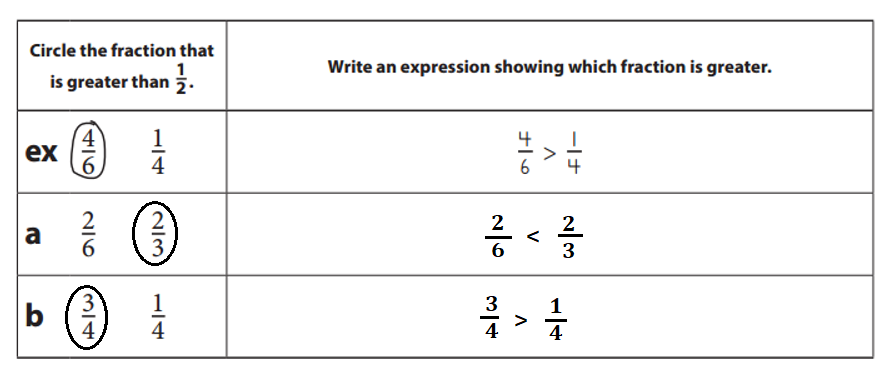
Explanation:
Given Fractions:
a. \(\frac{2}{6}\) \(\frac{2}{3}\)
=> \(\frac{1}{3}\) \(\frac{2}{3}\)
=> 0.33 < 0.67.
=> \(\frac{1}{3}\) is lesser than \(\frac{2}{3}\).
b. \(\frac{3}{4}\) \(\frac{1}{4}\)
=> 0.75 > 0.25.
=> \(\frac{3}{4}\) is greater than \(\frac{1}{4}\).
Question 2.
Complete the table.

Answer:
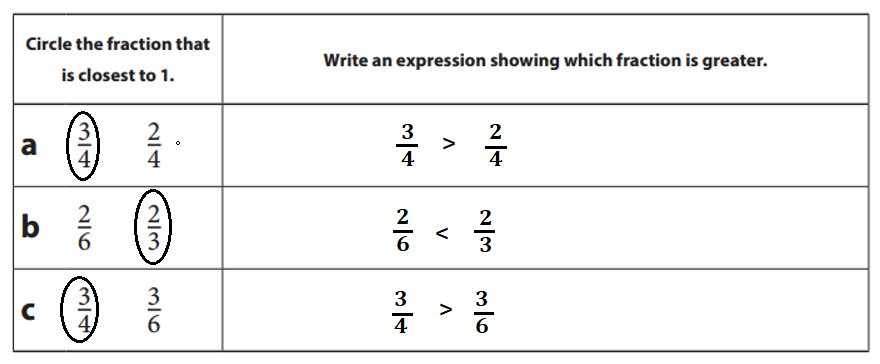
Explanation:
a. \(\frac{3}{4}\) \(\frac{2}{4}\)
=> \(\frac{3}{4}\) \(\frac{1}{2}\)
=> 0.75 is greater than 0.50.
=> \(\frac{1}{3}\) is lesser than \(\frac{2}{3}\).
b. \(\frac{2}{6}\) \(\frac{2}{3}\)
=> \(\frac{1}{3}\) \(\frac{2}{3}\)
=> 0.33 > 0.67.
=> \(\frac{2}{6}\) is lesser than \(\frac{2}{3}\).
c. \(\frac{3}{4}\) \(\frac{3}{6}\)
=> \(\frac{3}{4}\) \(\frac{1}{2}\)
=> 0.75 > 0.50.
=> \(\frac{3}{4}\) is greater than \(\frac{3}{6}\).
Bridges in Mathematics Grade 3 Student Book Unit 7 Module 4 Session 5 Answer Key
Lemonade & Bracelets
Question 1.
Philipe is making lemonade with his dad to serve at their party. Their recipe makes 6 glasses of lemonade. The recipe calls for 4 lemons, 1 cup of sugar, and 6 cups of water.
a. If they want to make enough lemonade for 30 people to drink a glass, how many lemons will they need to buy?
Answer:
Number of lemons they will need to buy = 120.
Explanation:
Number of glasses of lemonade their recipe makes = 6.
Number of lemons the recipe calls = 4.
Number of cups of sugar the recipe calls = 1.
Number of cups of water the recipe calls = 6.
Number of people = 30.
Number of lemons they will need to buy = Number of people × Number of lemons the recipe calls
= 30 × 4
= 120.
b. Use words, numbers, or pictures to explain how you know your answer above makes sense.
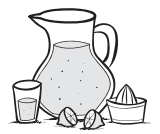
Answer:
Number of lemons they will need to buy = 120 makes sense because it is accurate and correct as its only way to find the lemons needed.
Explanation:
Number of glasses of lemonade their recipe makes = 6.
Number of lemons the recipe calls = 4.
Number of cups of sugar the recipe calls = 1.
Number of cups of water the recipe calls = 6.
Number of people = 30.
Number of lemons they will need to buy = Number of people × Number of lemons the recipe calls
= 30 × 4
= 120.
Question 2.
Lisa is making bracelets for four of her friends. She needs 18 beads for each bracelet.
a. How many beads does she need in all?
Answer:
Number of beads she needs in all = 72.
Explanation:
Number of friends Lisa is making bracelets = 4.
Number of beads for each bracelet she needs = 18.
Number of beads she needs in all = Number of friends Lisa is making bracelets × Number of beads for each bracelet she needs
= 4 × 18
= 72.
b. Use words, numbers, or pictures to explain how you know your answer above makes sense.
Answer:
Number of beads she needs in all = 72 makes sense because its only way to find how many beads needed in total.
Explanation:
Number of friends Lisa is making bracelets = 4.
Number of beads for each bracelet she needs = 18.
Number of beads she needs in all = Number of friends Lisa is making bracelets × Number of beads for each bracelet she needs
= 4 × 18
= 72.
c. CHALLENGE If each bead costs 15¢, how much would it cost for Lisa to buy all those beads? Show your work.

Answer:
Total cost of all beads neded = 1,080 ¢.
Explanation:
Cost of each bead = 15¢.
Number of beads she needs in all = 72.
Total cost of all beads neded = Cost of each bead × Number of beads she needs in all
= 15¢ × 72
= 1,080 ¢.